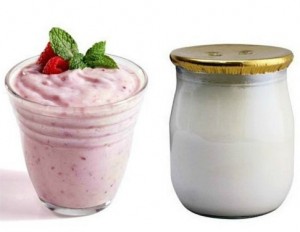 Yogurt or yoghurt is a dairy product produced by bacterial fermentation of milk. The bacteria used to make yogurt are known as “yogurt cultures”. Fermentation of lactose by these bacteria produces lactic acid, which acts on milk protein to give yogurt its texture and its characteristic tang.
Yogurt or yoghurt is a dairy product produced by bacterial fermentation of milk. The bacteria used to make yogurt are known as “yogurt cultures”. Fermentation of lactose by these bacteria produces lactic acid, which acts on milk protein to give yogurt its texture and its characteristic tang.
Worldwide, cow’s milk is most commonly used to make yogurt, but milk from water buffalo, goats, sheep, camels and yaks is also used in various parts of the world. In theory, the milk of any mammal could be used to make yogurt. Soy Milk can also used as an alternative in making yogurt, it is called Soya yogurt, a non-dairy yogurt.
Yogurt is nutritionally rich in protein, calcium, riboflavin, vitamin B6 and vitamin B12. It has nutritional benefits beyond those of milk. People who are moderately lactose-intolerant can consume yogurt without ill effects, because much of the lactose in the milk precursor is converted to lactic acid by the bacterial culture. Yogurt containing live cultures is sometimes used in an attempt to prevent antibiotic-associated diarrhea.
To offset its natural sourness, yogurt can be sold sweetened, flavored or in containers with fresh fruit or fruit jam on the bottom. Fruit jam is more often used instead of raw fruit pieces in fruit yogurts to allow storage for weeks. It is easy and inexpensive to make yogurt at home.
Materials:
You will need fresh milk (if you own a dairy cow) or instant powdered whole milk, and unflavored yogurt. This will serve as a yogurt starter, and its shelf life should be six months form the time of purchase.
Equipment:
You will need a stove, a small stainless pot that will hold about a liter of milk, a thick wad of newspaper, a string, and a thermometer (if available).
Procedure:
- Heat 1 liter of purified water to about 60 degrees Centigrade.
- Dissolve about three-fourth cup of instant milk or pasteurized fresh milk in the heated water and stir until well blended;
- Mix the yogurt with the blended milk and immediately transfer the pot in the middle of a thick wad of newspaper. Gather all sides of the newspaper and tie at the middle. This is to retain the heat for at least three hours;
- Check the mixture after four hours. If it has curdled, then the preparation is successful. If not, the yogurt starter may have expired, the milk blend may have been too hot and killed the good bacteria that curdle the milk, or the milk is not hot enough to provide a good environment for bacteria to grow;
- Fill eight cups (125 ml) with yogurt, cover it, and refrigerate. Each serving only costs P5.
Sources: en.wikipedia.org, agriculture magazine